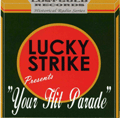Your Hit Parade
| Your Hit Parade | |
|---|---|
 |
|
| Genre | Music |
| Directed by | Norman Jewison (1958-59) |
| Starring |
Dorothy Collins Snooky Lanson Gisele MacKenzie Bobby Phillips Russell Arms Eileen Wilson June Valli Sue Bennett Virginia Gibson Alan Copeland Tommy Leonetti Jill Corey Johnny Desmond Raymond Scott Frank Sinatra |
| Narrated by | Andre Baruch |
| Country of origin | US |
| Original language(s) | English |
| Production | |
| Producer(s) | Dan Lounsbery |
| Running time | 25 minutes |
| Release | |
| Original network |
NBC (1950–1958) CBS (1958–1959) |
| Audio format | Monaural |
| Original release | July 10, 1950 – April 27, 1959 |
Your Hit Parade is an American radio and television music program that was broadcast from 1935 to 1955 on radio, and seen from 1950 to 1959 on television. It was sponsored by American Tobacco's Lucky Strike cigarettes. During this 24-year run, the show had 19 orchestra leaders and 52 singers or groups. Many listeners and viewers casually referred to the show with the incorrect title The Hit Parade.
When the show debuted, there was no agreement as to what it should be called. The press referred to it in a variety of ways, with the most common being "Hit Parade," "The Hit Parade," and even "The Lucky Strike Hit Parade" (see for example "Lucky Strike Hit Parade is Popular," Laredo (Texas) Times, May 21, 1935, p 7). The program's title was not officially changed to "Your Hit Parade" until November 9, 1935 ("Al Goodman to Be Maestro on Radio Series," Oakland Tribune, November 9, 1935, p. 14.)
Each Saturday evening, the program offered the most popular and bestselling songs of the week. The earliest format involved a presentation of the top 15 songs. Later, a countdown with fanfares led to the top three finalists, with the number one song for the finale. Occasional performances of standards and other favorite songs from the past were known as "Lucky Strike Extras."
Listeners were informed that the "Your Hit Parade survey checks the best sellers on sheet music and phonograph records, the songs most heard on the air and most played on the automatic coin machines, an accurate, authentic tabulation of America's taste in popular music." However, the exact procedure of this "authentic tabulation" remained a secret. Some believe song choices were often arbitrary due to various performance and production factors. The show's ad agencies—initially Lord and Thomas and later Batten, Barton, Durstine & Osborne—never revealed the specific sources or the methods that were used to determine top hits. They made a general statement that it was based mainly on "readings of radio requests, sheet music sales, dance-hall favorites and jukebox tabulations"; Radio Guide claimed "an endless popularity poll on a nationwide scale."
The origins of the format can be traced back to the Lucky Strike Dance Orchestra (aka Lucky Strike Orchestra), which aired from 1928 to 1931, sponsored by Lucky Strike cigarettes. Led by Benjamin A. Rolfe the show was heard on the NBC Red network for an hour at 10 p.m. on Saturdays (with Tuesday and Thursday broadcasts beginning around September 16 and 18, 1930, respectively). The program introduced the slogan, "Reach for a Lucky instead of a sweet." In a cross-promotion, Rolfe made recordings for Edison Records as B.A. Rolfe and his Lucky Strike Orchestra. Jules Stein's Music Corporation of America was the exclusive supplier of bands for The Lucky Strike Dance Hour, which beginning around November 1931 became The Lucky Strike Magic Carpet Show, hosted by Walter O'Keefe and featuring Anson Weeks and his orchestra with dramatizations of cases from the New York Police Department on Tuesdays, Jack Denny's band with news stories narrated by Walter Winchell (then a gossip columnist for Hearst's tabloid New York Daily Mirror, featuring a style different from the one is more remembered for) on Thursdays, George Olsen and his orchestra on Saturdays, and during the summer of 1932, the Saturday night broadcasts would feature comedian Bert Lahr. Beginning in fall 1932, the show was scaled back to Saturdays, with Weeks as the main conductor, who remained on the program until its end in 1934, then heard as a half-hour show on Wednesday evenings at 8 p.m., E.S.T.
...
Wikipedia
